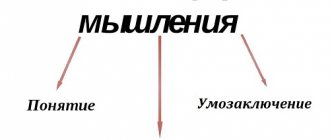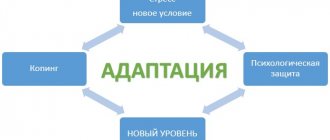Many of us are accustomed to thinking in only one way, and this leaves its mark on a person’s entire life: work, study, success, career, financial condition, satisfaction, romantic relationships, family, communication with others. And if the result is in some way unsatisfactory, the thinking model can and even needs to be changed. All that is required for this is to master at least a few thinking techniques that differ from the ordinary one. In this collection, we will introduce you to different thinking techniques, help you learn to think differently, and therefore act more effectively.
1
Development of thinking: ways to train the brain
Thinking can rightfully be called the crown of human knowledge. It is a mental activity with its own goals, motives, operational functions and results. It can be characterized in different ways, but, regardless of interpretation, it can be established that the better a person’s thinking is developed, the more effectively he can interact with the world around him and other people, study and cognize, understand phenomena and truths. In addition, everyone is capable of developing their own thinking, and we will talk about how this is done in this article. Read more…
2
Stages
Experts in the field of child psychology and pedagogy identify several stages in the development of children's thinking.
Visually effective
The earliest stage in the development of children's consciousness is the age of 1.5-2 years. At this time, babies are in the process of exploring the world with their hands. In order to assimilate some information about the environment, the child needs to touch everything, take it into his own hands, take something apart and even break it, try it out. Thus, objects are learned through variable actions performed on them and observation of what will happen. This thinking is called visually effective.
Visual-figurative type
The line of development of visual-figurative thinking joins the visual-effective type of comprehension at the age of 3-4 years. These two types of thinking develop in parallel, harmoniously complementing each other.
A striking example of this is drawing. Children begin to draw on paper the pictures of the world around them that have developed in their minds. These paintings are simple and primitive (for example, a house with a triangular roof and a window), but this is a reflection of visual-figurative thinking
Therefore, it is very important during this period to focus on drawing, modeling, design, applique
It should be noted that the connecting link and step that allows one to gradually move from the visual-figurative type of consciousness to the verbal-logical one is combinatorial thinking.
Verbal-logical
The stage of development of another important type of thinking - verbal-logical - begins at the age of 5-7 years. It makes it possible not only to talk about the facts of reality, but also to analyze the environment and verbally voice this analysis in a variety of ways.
If you ask a child aged 3-4 years what a dog is, he will answer that it is Tuzik, who lives in the yard. And at the age of 5-6 years he will say that this is an animal that guards the house and loves to wag its tail when it is petted. The difference between the answers is obvious. In the latter case, the child demonstrates his ability to analyze information and express it logically using words. This operation of consciousness is the most important basis of the thinking process; it allows preschool children to develop and move upward and forward in knowledge.
Creative
Creative thinking allows a person (in this case, a child) to create something completely new and make some non-standard engineering solutions. And the development of these capabilities and abilities largely depends on the child’s parents. There are no children who are completely lacking in creativity. Everyone has it, and parents who want to develop such abilities in their children should know and remember this.
Any direction (literary, artistic, dance, music, etc.), as well as the sensitive guidance of experienced teachers, can help with this.
It is necessary to take into account the fact that creative thinking does not depend either on the physical growth and development of the child, or on his intellectual abilities.
Mental operations
In the process of evolution of views on the nature and essence of the thought process, the issue of the formation of mental operations attracted special attention of scientists. Thinking, unlike other physiological processes, occurs on the basis of a certain logic. This allows you to identify individual structural elements (abstraction, analysis and synthesis, classification and categorization, specification, generalization, comparison) and characterize them. The patterns of functioning of the named operations of thinking are essentially the main internal, specific foundations of thinking. Their study helps to obtain a detailed explanation of all external manifestations of mental activity. Read more…
4
Two Ways of Thinking by Carol Dweck
In 2007, American psychologist Carol Dweck published a book called Mindset, where she argued that intelligence, talent and education do not necessarily lead a person to success. The main criterion is the way of thinking and how a person copes with life’s problems, difficulties and challenges. In this article, we'll explore what Carol Dweck's mindset is and how a fixed mindset can harm you when developing it will help you achieve your goals, increase self-motivation, and increase productivity. Read more…
5
Harmful Thinking Styles
Harmful thinking styles are sometimes called cognitive distortions. These are systematic deviations in behavior, perception and thinking, caused by prejudices and stereotypes, failures in processing and analyzing information, as well as physical limitations and structural features of the human brain. These thinking styles are based on automatic patterns that we follow throughout our lives. If they are not recognized, the problem will remain and will affect all areas. With them it is impossible to realize your full potential. There are many harmful thinking styles, so in this article we will list only a few, and then show you how to get rid of the most catastrophic of them. Read more…
6
Speech structure
From the point of view of effective thinking, speech consists of two main parts.
- The main course is a chain of statements that contains the main meaning.
- Side dish - additional information that does not change the main meaning in any way, serves to captivate the audience and create the context of the “story”. In general, what is now called storytelling.
Very often speech looks like a huge station pie. It's big on the outside, but when you start eating it, you find that it takes quite a while to get to the filling.
After understanding this structure, it is important to separate the two types of perception. And consciously make a choice which perception to include now, and what the result will be after that.
The first type of perception is that we eat a side dish mixed with the main dish and enjoy the taste.
Pros - it is easier to immerse yourself in history, receive sensual - emotional pleasure. Cons - a skillful speaker will easily lead you to any conclusions. Well, if the content is completely truthful, then the quality of its development and understanding will be much worse. Don't rush to object. Try to apply, compare and see for yourself.
The second type of perception is that we strictly cut off the side dish and conduct a strict analysis of the main dish.
Pros - understanding becomes as great as possible. There is a clear understanding of what questions need to be asked in order to make the picture as clear as possible. It is these questions that will easily expose a charlatan in one case, or will give the impression of sincere interest to a good specialist in another.
After the work done, the reward will be a feeling of satisfaction.
Cons: You won’t be able to immerse yourself in the story and relax. If the subject of the conversation is complex, then you can get seriously tired.
Applying design thinking to life
Bill Barnett, in his book Designing Your Life: How to Build a Well-Lived, Joyful Life, teaches people to apply the principles of design thinking (a strategy for improving a product or experience) in their personal and professional lives. Design thinking is a problem-solving system that uses mental, creative and analytical skills. Typically, designers look at business problems, but design thinking can also be used by the average person. Marelissa Fabrega in her article analyzes design thinking and gives advice to those who want to improve their lives with its help. Read more…
7
Process
Few people think about how to think correctly. The process itself occurs automatically. It all starts with preparation, which allows you to determine the conditions of the problem.
Important! The sequence of stages of the cognitive process is strict and cannot be violated. The second stage is more extensive - finding a solution
It is carried out on the basis of existing experience or involves the formation of a new algorithm. The learning process does not always lead to a positive result. In the case of a negative experience, disappointment sets in
The second stage is more extensive - finding a solution. It is carried out on the basis of existing experience or involves the formation of a new algorithm. The learning process does not always lead to a positive result. In the case of a negative experience, disappointment sets in.
Sometimes a person has an insight, i.e. sudden insight. This is expressed as a mental instant solution to a problem. This phenomenon can occur in confident people who collect a large amount of information and believe in their success.
With divergent thinking, a hypothesis is developed that is confirmed or refuted during the study of the situation. With this type, creative abilities develop. With intuitive cognition, an individual relies more on feelings and sensations that tell him which option is better to choose.
Harson's productive thinking model
Creativity is essential to solving any problem. If you are not creative and more logical, you will not be able to evaluate the problem from different points of view and come up with an unusual and simple solution. And if you combine critical and creative thinking, your effectiveness increases significantly. Harson's productive thinking model will help you do this. This model encourages using both sides of the brain and alternating between creative thinking and critical and logical thinking. This means that you can look at a problem from different angles and find the best solutions. Read more…
8
We are building a mental machine.
The construction itself is as follows:
- We construct the first statement (verbally, cutting off the unnecessary).
- In the statement, we check both the essence and the action for payback. If there is no payback, we ask questions and look for answers.
- We hold entities and actions in the imagination in the form of images.
- Let's add the following statement.
- We are looking for with the help of what action or entity the second statement is linked to the first. Sometimes this is stated explicitly, sometimes it is not stated at all. If it is not indicated, but is, as it were, “implied,” then one must make the implied statement a new statement and explicitly turn the gears that make it up.
- Making the second statement pay off.
- We add the essence and action of the second statement in the form of images to the picture.
- We are trying to twist/change the resulting coupling.
- Repeat steps 4-8 for each new statement.
As a result, in our imagination we will have a model, each element that we understand thoroughly. This means that the model turns into a single mechanism, which, in turn, we can change as we want or use it as a tool anywhere.
It looks cumbersome, but in reality many steps can be done very quickly. And after you get the hang of it, you can almost instantly distinguish payable entities/actions from non-payoff ones.
Main mistakes:
“They wasted a lot of time memorizing things like that when they could have been found and viewed in fifteen minutes.” Richard Feynman.
- Skip any entities/actions because they seem obvious to you. They may be obvious in other contexts. But it is not a fact that this will be obvious. Also, their influence/coupling with neighboring entities/actions may not be very obvious.
- To be lazy about twisting/twirling entities and actions. Understanding is never built through memorization. Only through interaction with entities and actions.
Design Thinking: What is it and How to Apply It
How to combine design and business? This question has been asked by many entrepreneurs for decades, and they have finally found the answer - using design thinking - a human-centered technique that allows you to find non-standard solutions to problems. Design thinking is not an aesthetic, but a mental work that defines the principle of problem solving, builds processes and installs tools. What are its principles and how to implement it in your activities? We will talk about this in our article. Read more…
9
Analogy
Metaphorically, we can imagine that we are building a mechanism consisting of gears. By gear we mean essence. A very similar thing (from a slightly different direction) is described here as gearing.
The first question we ask ourselves is: “How can we move (twist, move) the gear?
Second : “What will happen to the gear itself if we twist/move it like that?”
Third : “What will happen to the nearby gears if we twist/move this one?”
If we move away from metaphor to reality, then we take the essence and ask ourselves - What properties does it have? As soon as we find any property, we begin to change it and ask ourselves: “What will happen?”
Changing the property is what I mean by “twist/twist/move”. The answer to the second and third questions is what I mean by a forecast. Let's move on to real examples.
Edward de Bono's Six Thinking Hats Method
Among other theories of creativity, the method of lateral thinking specialist Edward de Bono is distinguished by its youth. The Six Thinking Hats was first published in 1985, introducing the public to a technique for organizing thinking and a way to solve creative problems and disputes. Today, this technique has become popular enough to gain both its fans and opponents. Perhaps philosophers would consider it necessary in this situation to joke about the hermeneutic circle, saying that the methodology that defends different views on things is itself evaluated differently. But without irony, we will try to understand the essence of the 6 hats technique, its pros and cons, as well as its application possibilities. Read more…
10
More details about the concepts
It is impossible to understand this issue in detail without finding out the definitions of all terms. Thinking is the process of processing information data and bringing it to a specific conclusion. This ability gave rise to the emergence of speech, which we use to communicate with each other. People come to reflection in order to resolve all troubles and problems, explore the world around them, find out relationships and patterns. By thinking, a person creates innovations, makes scientific discoveries and finds himself in art. Without a mental component, we would be similar to ordinary animals that act within the framework of their instincts.
Forms of thinking are the result of thought and mental processes that manifest themselves in a specific situation, which allows one to understand the essence of phenomena and objects, determine the relationships of objects and notice general signs. There are only three varieties, which I will discuss in detail below.
Online program "Cognitive Science"
Within two months, with the help of special brain training, you will learn to apply more than 20 thinking techniques in your life. This will allow you to think logically and consistently, quickly make effective decisions and find innovative approaches to difficult problems. The lessons not only train general memory and logic skills, but also provide specific models and algorithms of thinking. While participating in the program, you will learn to apply your knowledge and skills in practice, receive examples, case studies, special games and exercises, and short lessons of 15-20 minutes will help you develop your thinking without distraction from your main activity and show results in the first week . Find out more...
We hope that now you will have more faith in your own strengths and confidence that getting rid of templates and ossified thinking is very simple. Good luck!
We make it worthwhile.
Payback is the ability to make accurate forecasts. A forecast is the answer to the question: “What will happen if you do this?”
Payback is possible only if we understand the essence of the phenomenon. And here we come across the main trap and at the same time a wild boost to thinking productivity. First I will formulate it, then I will explain it with examples.
Trap: very often understanding the essence is replaced by understanding the words.
Implications: Understanding words does not allow for accurate predictions.
An example of payback and accurate forecasts. There is a suggestion:
There is a wooden cube on the floor.
We have an entity - a small wooden cube. We begin to twist/twist. The cube has a property - position in space. If we change this property, we get the following questions:
“What happens if the cube is placed on the floor on one of its faces?”
“What happens if the cube is placed on the floor on its edge?”
Obviously, we can answer these questions accurately. In the first case, the cube will not move at all. In the second, the cube will fall on one of the faces and then stop moving.
An example of understanding words without understanding the meaning. There is a suggestion:
A note is a graphic designation of sound.
There is an essence - a note. It would seem that everything is clear. Since a note is a sound, a note has the same properties as a sound, such as pitch. We change this property and get the questions:
“And if the sound is made higher/lower by a few hertz, will it still be a note?
“Is every sound a note?”
“If not every sound is a note, then what distinguishes a note from a non-note?”
“How many notes are there?”
“Why so many?”
If you can answer these questions, congratulations, you have a real understanding of the essence of “note.” If not, then that's okay too. Most people mistake understanding words for understanding meaning. Indeed, from the point of view of understanding words, the sentence about the note is absolutely clear, not a single unfamiliar word.
That is, we take an entity and begin to change its properties. Twist and turn this way and that. If we understand what will happen, then we understand the essence well. If we don’t understand, then understanding is replaced by the feeling that the word is familiar to us.










